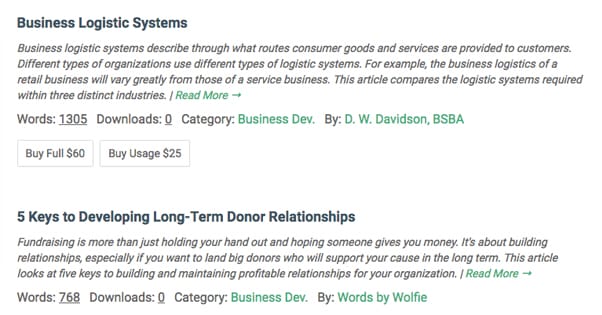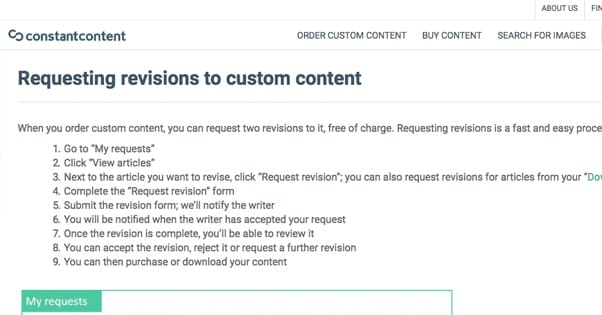Our Review of Quality and Pricing from Constant Content
Published by James Parsons • Content Marketing • Posted June 7, 2016 ContentPowered.com
ContentPowered.com
There are many options available if you want to buy articles online. We’ve reviewed some of them before. Today, the one I’m going to talk about is Constant Content.
Not to be confused with the email service provider Constant Contact, Constant Content is a marketplace for content. Writers can post articles they’ve written at prices they choose to set, or they can work on assignments posted by clients who have content they want written.
As a blogger looking to purchase content, you have free run of the site. You create an account and can search for topics at your leisure. Content is categorized and you get a preview description that is searchable, so you can search for keywords. When you find an article that looks promising, you can click to view it. This will show you the writer’s description of the article, an excerpt of the article, and the pricing. You can also click through to see a bio of the writer, in case you want to check their credentials or other work they have written.
Interestingly, you won’t be able to see the full text of the article, and the preview excerpt you get is presented in the form of an image. This is to prevent shady bloggers from stealing content that is publicly posted on the marketplace. Constant Content tries to protect their writers in this manner, since they can’t really go after scammers with legal action.
Article Pricing
Most articles will have two tiers of pricing, though many older posts will have three.
These are:
- Usage Rights. These are the cheapest, but you shouldn’t buy a post for usage rights. Why not? Well, they’re non-exclusive. Anyone can come in and buy a post for usage rights, and gain the rights to use the content. If you buy a post for usage rights and someone else has already bought and published the content, what do you get? You get content that someone else has posted. It’s copied content, and it’s something Google is going to devalue on your site.
- Unique Rights. These are going to be mid-tier pricing, trending towards the higher side. They give you the rights to the content publication, as is. The only things you are allowed to change are formatting like italics and bolding, and the addition of links. Changing the content itself can be considered a violation of the Constant Content terms of service and can get you blocked from the platform. This license is being phased out, however, and most modern content won’t have it as an option.
- Full Rights. This is the most expensive set of rights, but it gives you total control over the content. Like with unique rights, the content becomes yours and is taken off the platform, so no one else can buy or use it. However, you don’t have the change restrictions of unique rights. You are free to edit the post as you see fit, as much or as little as you like. Its your content now; the writer and Constant Content don’t care what you do with it.
Pricing runs a wide range of levels, because there’s no standard set by Constant Content itself. They have a chart of common prices internally for writers to view, but they aren’t beholden to it, and it hasn’t been updated in years. Writers are free to set their prices, and change them at any time. You can get a 1,000-word article for $25, or you might be asked for over $100 for one of the same length.
How much are you willing to pay? That’s the question you’re going to have to ask yourself. Often, the content with the higher pricing comes from more experienced, better professional writers. They charge what they know they’re worth. On the other hand, the content you get for cheap prices isn’t always bad content. It might be content that was ignored because it didn’t trend, and the writer has lowered the price in an attempt to get it to sell. Of course, it could actually be bad content. That’s what the preview is for; so you can determine if the content is a good fit for your blog.
Custom Requests
If you’ve searched and don’t see any content that fits the bill of what you want – wrong topics, too expensive, too short, too long, wrong perspective, etc – you can commission content directly. You have two options here. You can either order content publicly, or you can find writers privately.
A public request allows you to choose either an entirely open casting call, or a targeted request. The open casting call appears for all writers. Writers get to see your pitch, your pricing, and some basic information about you according to the profile you fill out. They submit content to you, and you can pick one or more pieces to buy. You don’t have any obligation to buy the content you don’t like, and the writer can just post it on the site publicly if you don’t want it, so there’s no loss or hard feelings.
Targeted requests are first sent to an editor. That editor reviews the request and checks through their stable of writers, looking for specific writers who have the expertise and the history in that category to fulfill your request. You have a higher chance of getting satisfactory content here, because you’re not having to sift through open orders. However, this is likely to be a little more expensive, because it’s a managed service. You can target by country, by topic, or even by certification from the writer.
On the private request field, you have casting calls and expert requests. Casting calls are similar to open pool orders, in that you post a pitch, except you don’t get content submitted to you. Instead, writers submit their credentials and experience, and sometimes a pitch for the post as well. You then pick a writer to hire and work with them to produce the content you want for your blog.
The expert request is like an open pool request, except the “open pool” becomes a closed specific pool of expert writers. These writers are professionals who have been vetted by the Constant Content editors and are known to be high quality content producers with experience in their chosen fields. You aren’t getting someone who Googled your topic 10 minutes before writing; you’re getting someone who knows their stuff. There are a limited selection of expert groups, however. They cover broad topics: Engineer, Health Care, Finances, Legal, Real Estate, Veterinary, Dental, and Marketing. If your blog doesn’t fall into one of those categories, you won’t be able to find an expert team.
In addition to choosing the request type, you choose the type of content as well. This can be just a normal blog post or copywriting assignment, or it can be something specific like an eBook, a press release, or a white paper. Functionally, many writers won’t necessarily know what the differences are, and many of the categories overlap.
Editing, Revisions, and Details
Unlike many of the other content mills, Constant Content doesn’t really offer you much in the way of revision requests. You only get the ability to work with a writer on revisions if you commissioned them directly. If you’re buying content from the open pool, and a post doesn’t fit your bill exactly, you really only have two options. You can buy the content for full rights and edit it to fit your blog, or you can commission the writer for a post “just like the one you write but with X changes made.” Really, the first option is more likely to work, as some writers won’t want to repeat content that way.
Even at the bottom of the barrel with content on Constant Content, you’re not going to be encountering the terrible garbage you see on sites like Textbroker. Every article posted to Constant Content is reviewed by an editor before it can be released for sale, and that editor requires the writer to follow certain spelling and grammar guidelines. If a post doesn’t read properly, is full of typos, or otherwise reeks of poor quality, it won’t be accepted. There’s also a plagiarism scanner involved, so you know all of the content is original – at least, as long as it wasn’t purchased for use rights before.
As far as quality for the prices goes, it really depends on what you have available in terms of time. You can find some great content for cheap if you spend the time looking for it, but if you just need some content right now, you’re probably going to have to buy some of the more expensive articles. You can commission custom content and get exactly what you want, but it’s going to typically cost more for higher quality work, because the most high quality writers need a high price to attract them to a casting call or open pool order.
Constant Content Overview
Overall, I would say that Constant Content is a great place to buy content, so long as you can afford it. Articles can run anywhere from $20 to $200, with the average hovering around $75 for high quality content. Longer content costs more, but it’s not an easy per-word scale, so you can’t predict the cost of the piece you find that’s idea. You can negotiate with writers via custom commissions, you can open up orders to a broad or targeted pool, and you can get cheap high quality content that way, with one caveat; it’s going to take time. The faster you want content, the more you’re going to have to pay or the worse it will have to be.
That said, so long as you have the budget to buy from the site, it’s easily one of the best sources of content that isn’t either dealing with a freelancer directly or working with a managed company.
The Writer’s Perspective
I’m covering this a little bit at the end because, well, it’s widely covered elsewhere on the web. Most of the Constant Content reviews you find are about using the site to make money, not about being a client and paying for content. I’m going to gloss over a lot of things, though, since you can interpolate it from the above.
Constant Content is a pretty great platform for writers, with a couple of big caveats. The number one caveat is that it’s a marketplace. There’s no guarantee that your content will sell this week, this month, or even this year. It might not sell at all. You need to be writing constantly – get it – to have the volume necessary to make a consistent income.
Constant Content takes 35% of the total price as their cut. This seems significant but it’s about par for the course, if you calculate things out from other content mills. That means if you price a piece at $100, you’re only getting $65. Price your content accordingly, and don’t try to race to the bottom with undercutting other writers. That hurts everyone, and it means you’ll end up with penny work and kill the platform.
It can sometimes take days for editors to review a piece when it’s put into the system. This is a growing problem based on the fact that so many clients are using the team and casting call options now, when they didn’t used to before.
All around, it’s a good site to use, particularly if you can find a niche and dominate it with lots of content. General advice is to write 3-5 posts about any given topic, because bloggers often want to buy more than one piece of content on a related theme, so you can sell all of that content to the same blogger. Experiment with lengths and topics to find what sells most consistently.
Out of all of the various ways to buy and sell content online, Constant Content is resting in a sweet spot. They’re not too draconic that they suppress good writers, but they’re not too expensive that they compete with managed blog companies. They’re a fine middle ground for most writers and bloggers to carve out a niche.









